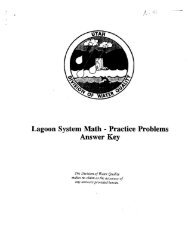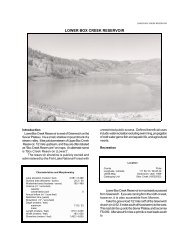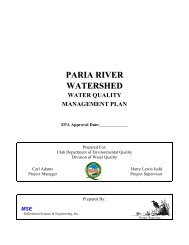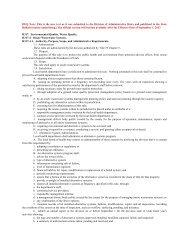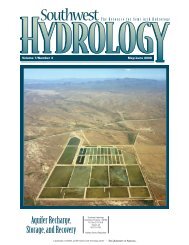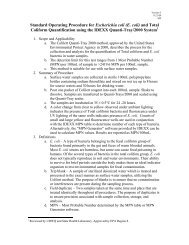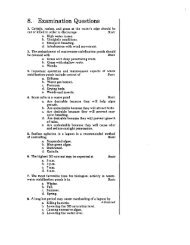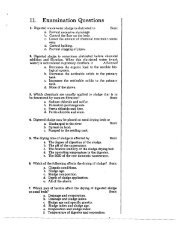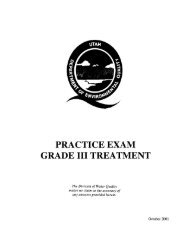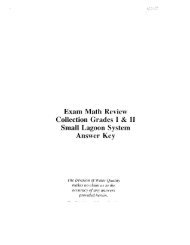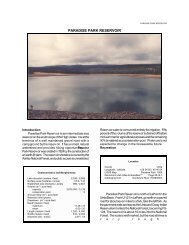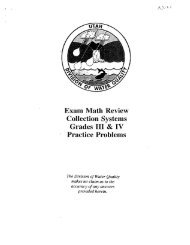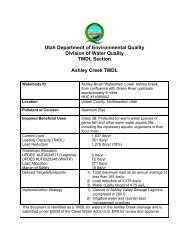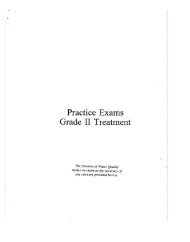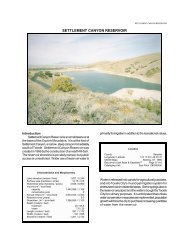Silver Creek - Division of Water Quality - Utah.gov
Silver Creek - Division of Water Quality - Utah.gov
Silver Creek - Division of Water Quality - Utah.gov
You also want an ePaper? Increase the reach of your titles
YUMPU automatically turns print PDFs into web optimized ePapers that Google loves.
<strong>Silver</strong> <strong>Creek</strong> <strong>Water</strong>shed TMDL Final Report<br />
2.0 WATER QUALITY STANDARDS<br />
The <strong>Silver</strong> <strong>Creek</strong> watershed is listed on the State <strong>of</strong> <strong>Utah</strong>’s 303(d) list as impaired for zinc and<br />
cadmium. Beneficial use 3A, protected for cold-water fish and other cold-water species, is<br />
identified as impaired. <strong>Water</strong> quality data and analysis are discussed in Sections 3 and 4. Data<br />
for the following constituents were gathered to quantify and evaluate this impairment:<br />
• Total and Dissolved Cadmium<br />
• Total and Dissolved Zinc<br />
• Total Dissolved Solids<br />
• Total Suspended Solids<br />
• pH<br />
Data for total dissolved solids and total suspended solids were gathered because metals such as<br />
zinc and cadmium are <strong>of</strong>ten present within these solids. Values for all <strong>of</strong> these constituents are<br />
sufficient to provide a good understanding <strong>of</strong> existing water quality impairments present in this<br />
area. Data for the constituents were gathered from the <strong>Utah</strong> <strong>Division</strong> <strong>of</strong> <strong>Water</strong> <strong>Quality</strong> (DWQ)<br />
and from the Environmental Protection Agency (EPA). Data beginning in January 1990 through<br />
2002 were obtained for monitoring stations located on or near <strong>Silver</strong> <strong>Creek</strong>.<br />
2.1 <strong>Water</strong> <strong>Quality</strong> Targets and Endpoints<br />
<strong>Water</strong> quality standards for zinc and cadmium were obtained from the State <strong>of</strong> <strong>Utah</strong>, Rule R317-<br />
2-14. This rule states that the standards for zinc and cadmium are dependent on the hardness <strong>of</strong><br />
the water. Hardness is used as a surrogate for a number <strong>of</strong> water quality characteristics which<br />
affect the toxicity <strong>of</strong> metals. Increasing hardness has the effect <strong>of</strong> decreasing the toxicity <strong>of</strong><br />
metals. <strong>Water</strong> quality criteria to protect aquatic life may be calculated at different concentrations<br />
<strong>of</strong> hardness measured in milligrams per liter (mg/l) as calcium carbonate (CaCO 3 ). (EPA,<br />
National Recommended <strong>Water</strong> <strong>Quality</strong> Criteria 2002, www.epa.<strong>gov</strong>/waterscience/pc/revcom.pdf.)<br />
Table 4 shows the equations provided by the State <strong>of</strong> <strong>Utah</strong> to calculate these standards.<br />
Table 4: <strong>Water</strong> <strong>Quality</strong> Standard Calculations<br />
Chronic<br />
Zinc e (0.8473(ln(hardness))+0.884)<br />
Cadmium e (0.7409(ln(hardness))-4.719)<br />
The average hardness measured in the <strong>Silver</strong> <strong>Creek</strong> watershed was found to be 484 mg/l. The<br />
equations shown in Table 4 that were used to calculate hardness adjusted water quality standards<br />
for zinc and cadmium are only considered valid up to a hardness <strong>of</strong> 400 mg/l. The use <strong>of</strong> a<br />
maximum hardness <strong>of</strong> 400 mg/l for calculating hardness adjusted water quality standards for<br />
metals is in accordance with <strong>Utah</strong>’s <strong>Water</strong> <strong>Quality</strong> Standards R317-2-14. <strong>Utah</strong>’s use <strong>of</strong> a<br />
maximum hardness <strong>of</strong> 400 was specifically recommended by Region 8 EPA in a letter to the<br />
<strong>Division</strong> dated Dec. 20, 2001. The National Recommended <strong>Water</strong> <strong>Quality</strong> Criteria: 2002 (EPA<br />
822-R-02-047 Nov. 2002) also specifically address this issue. At high hardness values such as<br />
Page 14



